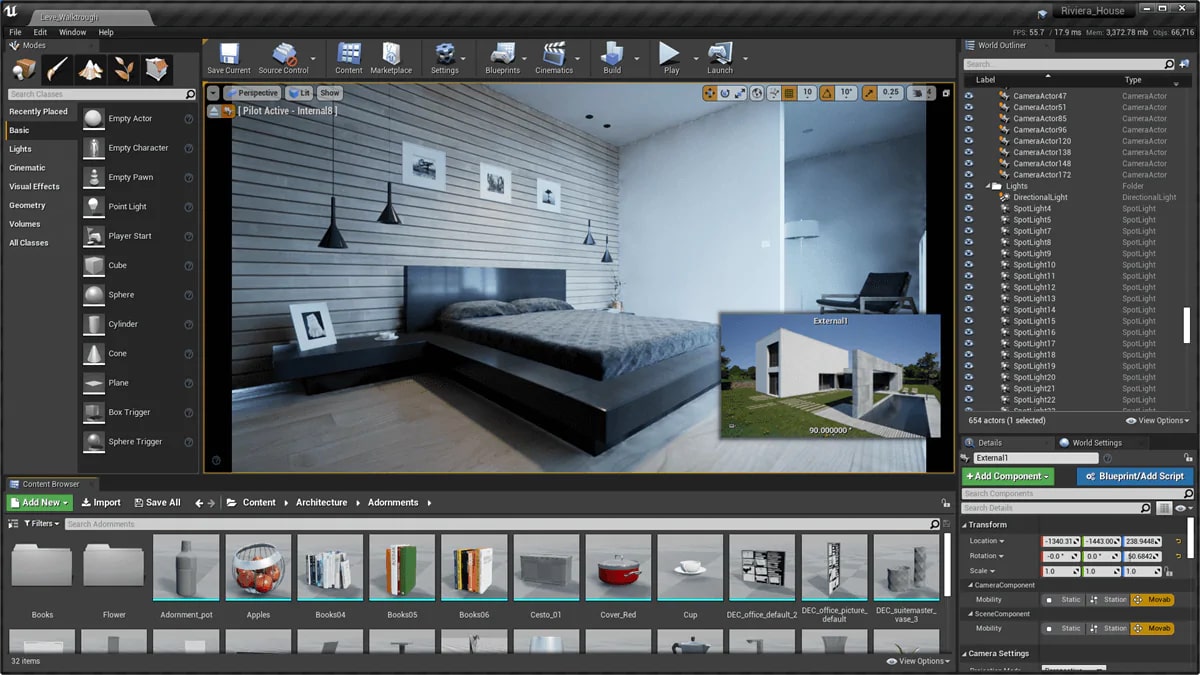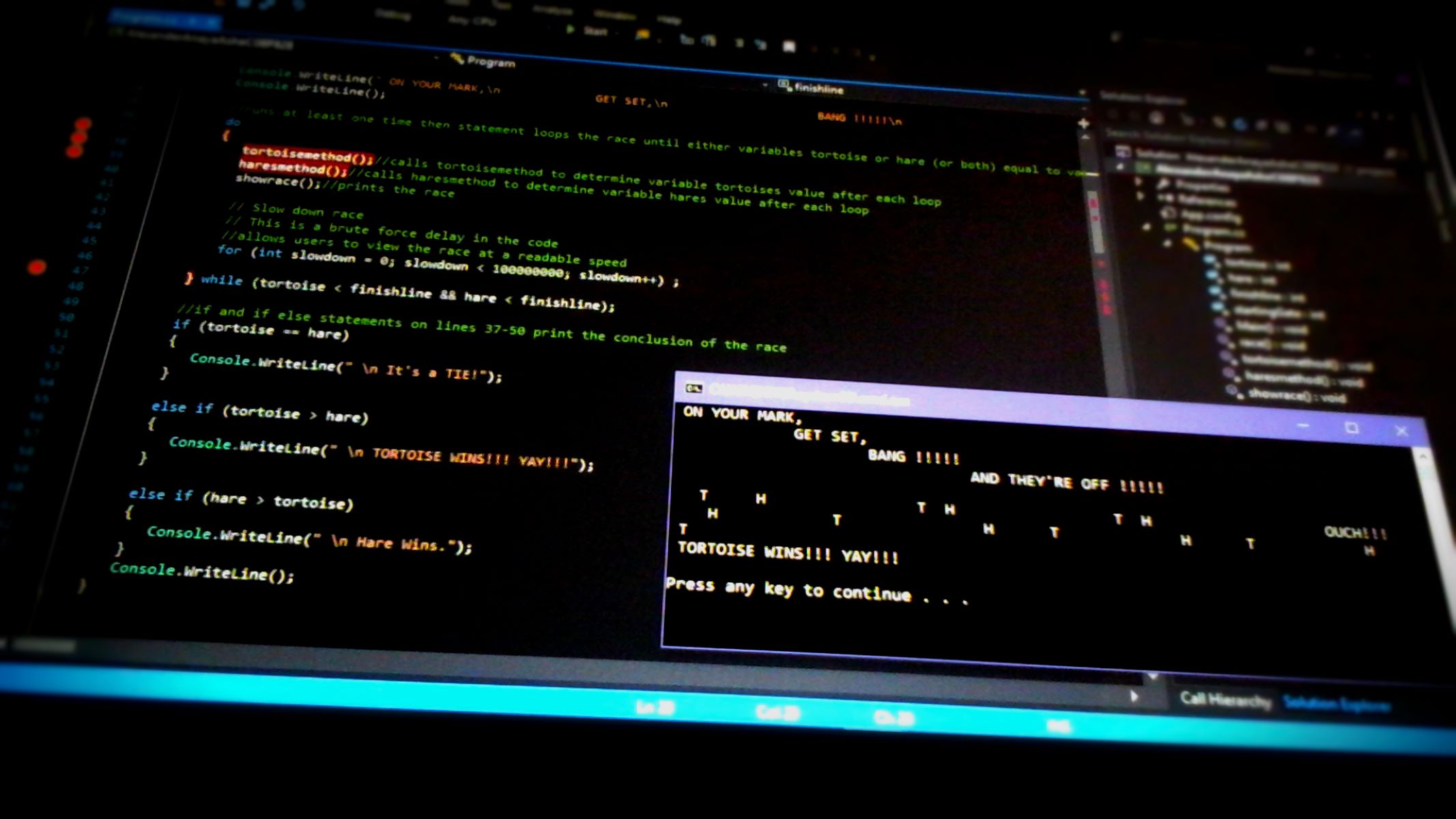Introduction
Welcome to the fascinating world of Unreal Engine 5, a powerful and cutting-edge development platform that catapults game creation to new heights. With its advanced features and stunning visual capabilities, Unreal Engine 5 has captured the attention of developers and gamers alike. As with any demanding software, it is crucial to understand the hardware requirements necessary to harness its full potential. In this article, we will explore the RAM (Random Access Memory) requirements for Unreal Engine 5 and delve into the factors that influence RAM usage within the engine.
Unreal Engine 5 is designed to facilitate the creation of highly immersive and visually striking games. This engine enables developers to leverage stunning graphics, realistic lighting, and dynamic environments to create immersive gaming experiences. However, these advanced features come at a cost, and one of the crucial hardware components that need to be considered is RAM.
RAM plays a vital role in the performance of Unreal Engine 5. It serves as the temporary storage space where data is accessed and manipulated in real time. When working with large game projects, complex scenes, and high-resolution assets, the amount of RAM available becomes a critical factor in ensuring smooth operation and efficient workflow.
Before we dive into the specific RAM requirements, it is important to understand that the needs may vary depending on the complexity and scale of your project. Smaller projects with simpler scenes and assets may require less RAM compared to larger projects with expansive open-world environments and high-resolution textures. However, having more RAM than the minimum recommended specifications can provide additional headroom for smoother performance and better efficiency.
Understanding Unreal Engine 5
Unreal Engine 5 is a state-of-the-art game development platform created by Epic Games. It introduces groundbreaking technology and features that push the boundaries of what is possible in game development. With its advanced real-time rendering capabilities, enhanced lighting systems, and improved asset management, Unreal Engine 5 empowers developers to create highly immersive and visually stunning games.
One of the standout features of Unreal Engine 5 is its Nanite virtualized micropolygon technology. This revolutionary technology allows developers to create incredibly detailed and realistic environments without sacrificing performance. Nanite analyzes the geometry of assets and dynamically streams only the necessary details, greatly reducing memory usage and enabling lifelike visuals even on lower-spec hardware.
Another key feature of Unreal Engine 5 is its Lumen global illumination system. Lumen provides dynamic, real-time lighting that reacts to changes in the environment. With Lumen, developers can create realistic lighting effects, such as accurate shadows, reflections, and global illumination, which greatly enhance the visual fidelity of the game.
In addition to these groundbreaking features, Unreal Engine 5 also offers improved asset management tools. The new and improved content browser streamlines the process of importing, organizing, and managing assets, making it more efficient for developers to work with large-scale projects. The engine also supports the use of Quixel Megascans, a vast library of high-quality 3D assets, textures, and materials, allowing developers to quickly populate their worlds with stunning and realistic objects.
Unreal Engine 5 also takes advantage of the power of next-generation hardware, such as the SSD (Solid State Drive), to drastically reduce load times and enable seamless streaming of assets. This enables developers to create more immersive and expansive game worlds, filled with detailed environments and interactive elements.
Overall, Unreal Engine 5 represents a significant leap forward in game development technology. Its advanced features and performance optimizations empower developers to create visually stunning and immersive games that push the boundaries of what is possible in interactive entertainment. Whether you are an experienced developer or just starting in the world of game development, Unreal Engine 5 unlocks a wide range of creative possibilities and sets the stage for the next generation of gaming experiences.
RAM Requirements for Unreal Engine 5
When it comes to RAM requirements for Unreal Engine 5, there is no fixed rule as the optimal amount of RAM can vary depending on several factors. These factors include the complexity of your project, the size of your game world, the number of assets and textures, and the level of detail you aim to achieve.
The minimum recommended RAM for Unreal Engine 5 is 16GB. However, for more ambitious projects and larger environments, it is advisable to have at least 32GB or even 64GB of RAM to ensure smooth performance and efficient workflow.
Keep in mind that while having more RAM can enhance the performance of Unreal Engine 5, it is not the only factor to consider. The overall performance of the engine is also influenced by other hardware components, such as the CPU and GPU. A well-balanced system with a powerful processor and graphics card is essential for optimal performance.
Additionally, it’s important to note that RAM requirements can vary depending on the target platform. Developing games for consoles or lower-end devices may have different RAM limitations compared to high-end gaming PCs. It’s essential to consider the specific hardware limitations of your targeted platforms to ensure optimal performance and compatibility.
Another key consideration is the size and complexity of your project. Larger game worlds, complex scenes, and high-resolution textures will require more RAM to store and manipulate the data efficiently. If you’re working on an open-world game with vast environments and numerous assets, it is recommended to have more RAM to handle the increased data load.
Moreover, if you plan to utilize advanced features like dynamic lighting, real-time global illumination, or complex physics simulations, additional RAM may be beneficial. These features require extra memory to process and store the data needed for calculations and rendering.
To summarize, while the minimum recommended RAM for Unreal Engine 5 is 16GB, it is advisable to have at least 32GB or 64GB for more ambitious projects with larger game worlds and higher levels of detail. Carefully consider the complexity of your project and the target platform’s limitations to ensure optimal performance and a seamless development experience.
Factors Affecting RAM Usage in Unreal Engine 5
RAM usage in Unreal Engine 5 can be influenced by several factors. Understanding these factors is crucial for optimizing performance and managing memory efficiently. Let’s explore the key aspects that affect RAM usage in the engine:
Game World Size and Complexity: The size and complexity of your game world play a significant role in RAM usage. Large and expansive environments with intricate details require more memory to store the necessary assets, terrain data, and textures. Additionally, levels with a high number of objects, characters, and interactive elements will also increase RAM usage.
Asset Count and Resolution: The number and resolution of assets used in your project directly impact RAM usage. High-resolution textures, complex 3D models, and detailed animations consume more memory. When working with a large number of assets, it is important to optimize their size and resolution to minimize RAM usage without sacrificing visual quality.
Dynamic Lighting and Shadows: Unreal Engine 5’s advanced lighting system, including real-time global illumination and dynamic shadows, can significantly impact RAM usage. Complex lighting calculations and shadow maps require additional memory to store and process the necessary data for accurate lighting effects. Therefore, extensive use of dynamic lighting can lead to increased RAM requirements.
Physics Simulations: Unreal Engine 5 provides robust physics simulation capabilities. Simulations for collisions, particle systems, and destructible objects require memory to store the physics data. The more complex and detailed the physics interactions in your game, the more RAM it will consume.
Level Streaming and LODs: Level streaming allows for seamless transition between different sections of the game world, loading and unloading assets as needed. However, each streamed level adds to the RAM usage. Additionally, using Level of Detail (LOD) systems to optimize assets based on their distance from the camera can also impact memory usage, as multiple versions of assets with varying levels of detail need to be stored.
Post-processing Effects: Unreal Engine 5 offers a wide array of post-processing effects, such as bloom, depth of field, and motion blur. While these effects enhance the visual quality of your game, they may require additional memory to store the intermediate results of these calculations.
Third-Party Plugins and Assets: Integrating third-party plugins and assets into your project can also affect RAM usage. It’s essential to carefully manage and optimize these assets to ensure they do not burden the memory unnecessarily.
Optimizing RAM usage in Unreal Engine 5 involves finding the right balance between visual fidelity and performance. Understanding these factors and making conscious decisions regarding the size, complexity, and optimization of assets and effects will help you achieve the desired results while efficiently managing memory usage.
Recommended RAM for Different Project Sizes
The recommended amount of RAM for your Unreal Engine 5 project depends on the size and complexity of your game. Here are some general guidelines to help you determine the appropriate RAM allocation for different project sizes:
Small Projects: For small-scale projects with simpler scenes and limited asset counts, 16GB of RAM should be sufficient. This includes projects with small game worlds, low-resolution textures, and minimal post-processing effects. Keep in mind that having a bit of extra RAM, such as 32GB, can provide more headroom and allow for smoother performance if you plan to expand your project in the future.
Medium Projects: Medium-sized projects with moderate complexity, larger game worlds, and higher-resolution assets will benefit from having 32GB of RAM. This includes games with detailed environments, medium-sized character rosters, and advanced lighting and post-processing effects. Having adequate RAM ensures smooth operation and reduces the likelihood of performance issues, especially during resource-intensive tasks.
Large Projects: For ambitious, large-scale projects with expansive open-world environments, high-resolution assets, and advanced visual effects, it is recommended to have a minimum of 64GB of RAM. These projects typically involve complex scenes, numerous objects, intricate character interactions, and advanced physics simulations. Having ample RAM allows for efficient storage and manipulation of the vast amount of data required for such projects.
In addition to the project size, it is also important to consider the target platform and any specific limitations or requirements it may have. Consoles or mobile devices may have RAM limitations that need to be taken into account during development. Always consult the documentation and guidelines provided by the target platform to ensure optimal performance and compatibility.
It’s worth mentioning that these recommendations are not set in stone, and the RAM requirements can still vary based on the specific demands of your project. Regularly assess the performance of your project during development and testing phases to identify any potential bottlenecks or memory issues. Adjusting the RAM allocation accordingly can help optimize performance and ensure a smooth gameplay experience for your players.
Remember, having more RAM than the minimum recommended specifications can provide additional headroom for future scalability and can aid in smoother performance during development and testing phases. Consider your project’s unique requirements, budget, and performance goals when deciding on the appropriate RAM allocation for your Unreal Engine 5 project.
Optimizing RAM Usage in Unreal Engine 5
Efficiently managing RAM usage is crucial for optimizing the performance of your Unreal Engine 5 project. Here are some strategies and techniques to help you optimize RAM usage:
Use LODs (Level of Detail): Implementing LOD systems for assets allows for the rendering of lower-detail versions of objects as they move away from the camera. This can significantly reduce the memory footprint by loading and rendering simpler versions of assets when they are less visible.
Optimize Textures: Textures consume a significant amount of memory. Optimize your textures by reducing their resolution or using compression techniques without sacrificing visual quality. Consider using texture streaming to dynamically load only the necessary parts of textures at runtime to conserve memory.
Manage Asset Sizes: Be mindful of the size of individual assets in your project. Large assets, such as high-poly 3D models or high-resolution textures, consume more memory. Optimize asset sizes by removing unnecessary detail or using efficient compression algorithms.
Stream Assets: Utilize Unreal Engine 5’s asset streaming capabilities to load and unload assets based on the player’s location. This helps optimize memory usage by only loading assets when they are needed, reducing the overall RAM footprint.
Remove Unused Assets: Regularly review your project for unused or redundant assets. Eliminating unnecessary assets not only saves disk space but also reduces RAM usage during runtime.
Implement Memory Pooling: Use memory pooling techniques to reuse memory for frequently allocated and deallocated objects. This helps minimize the overhead of memory management and reduces the strain on RAM.
Optimize Lighting: Unreal Engine 5’s advanced lighting features can impact memory usage. Experiment with adjusting the quality and complexity of lighting effects to find the balance between visual appeal and memory efficiency.
Optimize Physics Simulations: Complex physics simulations can consume a significant amount of memory. Optimize physics calculations by adjusting the level of detail and ensuring efficient memory usage for physics-based objects and interactions.
Profile and Monitor: Constantly profile and monitor the RAM usage of your project during development and testing phases. Use Unreal Engine’s performance analysis tools to identify potential memory issues and optimize accordingly.
Utilize Blueprint Scripts: Carefully manage the creation and destruction of objects through Blueprint scripts. Effective memory management in your code can reduce memory leaks and improve overall memory efficiency.
Regularly Update Engine Version: Stay updated with the latest Unreal Engine 5 releases. Engine updates often include performance improvements and memory optimizations that can contribute to more efficient RAM usage.
By implementing these strategies and techniques, you can optimize RAM usage in Unreal Engine 5, leading to improved performance, reduced memory overhead, and a smoother gaming experience for your players.
Tips for Managing RAM Usage in Unreal Engine 5
Managing RAM usage in Unreal Engine 5 is crucial for maintaining optimal performance and efficient workflow. Here are some tips to help you effectively manage RAM usage:
1. Plan Ahead: Before starting your project, evaluate the scope and requirements. Understand the size of your game world, the number of assets, and the level of detail needed. This will help you estimate the RAM requirements and plan resource allocation accordingly.
2. Optimize Asset Sizes: Reduce the memory footprint of your assets by optimizing their sizes. Compress textures, simplify 3D models, and remove unnecessary detail without compromising visual quality. Smaller asset sizes result in reduced RAM usage.
3. Use Proxy Geometry: Utilize proxy geometry for distant or less important objects in your game world. Proxy geometry provides a simplified representation of objects, reducing the amount of memory required to render them and optimizing RAM usage.
4. Enable Texture Streaming: Implement texture streaming to load textures dynamically as the player moves through the game world. This ensures that only the required textures are loaded into memory, minimizing RAM usage.
5. Monitor Asset Instances: Keep track of the number of instances of each asset in your project. Having a large number of duplications can unnecessarily increase RAM usage. Use asset instancing or procedural generation techniques to manage memory efficiently.
6. Manage Level Streaming: Break your game world into smaller, manageable chunks using level streaming. Load and unload levels as needed to optimize memory usage. This helps ensure that only the necessary data is stored in memory at any given time.
7. Limit Reflection and Shadow Quality: Realistic reflections and shadows can be computationally expensive. Adjust the quality and complexity of these effects to strike a balance between visual fidelity and memory usage.
8. Unload Unnecessary Assets: Regularly review your project for unused or unreferenced assets. Unloading unnecessary assets from memory reduces RAM usage, allowing more resources for active gameplay elements.
9. Implement Object Pooling: Utilize object pooling techniques for frequently created and destroyed objects, such as projectiles or particles. Reusing memory instead of constantly allocating and deallocating can reduce memory fragmentation and optimize RAM usage.
10. Use Level of Detail (LOD): Implement LOD systems for objects that scale their level of detail based on distance from the camera. This reduces the amount of memory needed for rendering objects that are further away, optimizing RAM usage.
11. Optimize Code: Write efficient and optimized code to minimize unnecessary memory allocations and deallocations. Regularly profile and debug your code to identify any memory leaks or performance bottlenecks.
12. Test and Iterate: Continuously test and monitor RAM usage during your development process. Use Unreal Engine’s profiling tools to identify areas where memory usage can be optimized. Iterate on your project to improve memory efficiency and eliminate unnecessary memory overhead.
By following these tips, you can effectively manage and optimize RAM usage in Unreal Engine 5, ensuring efficient resource allocation and delivering a high-quality gaming experience with smooth performance.
Conclusion
Optimizing and managing RAM usage in Unreal Engine 5 is essential for maintaining optimal performance and efficient development workflow. Understanding the factors that affect RAM usage, such as game world size, asset count, and complexity, allows you to make informed decisions when allocating resources.
Based on the size of your project, we recommend having a minimum of 16GB of RAM for small projects, 32GB for medium projects, and 64GB for large projects. However, it’s important to consider the specific requirements of your game and the limitations of your target platform when determining the optimal RAM allocation.
To optimize RAM usage, employ strategies such as using LODs, optimizing asset sizes and textures, enabling texture streaming, and efficiently managing level streaming and asset instances. Additionally, monitor and profile your project’s RAM usage regularly to identify and address any potential memory issues.
Remember to balance visual fidelity with performance by adjusting lighting and post-processing effects, as well as implementing object pooling and code optimization techniques. These measures will help minimize memory overhead and enhance the overall efficiency of your Unreal Engine 5 project.
By implementing these recommendations and adopting a thoughtful approach to managing RAM usage, you can create visually stunning and immersive games with smooth performance, optimizing the hardware resources available and delivering an exceptional gaming experience to your players.

























